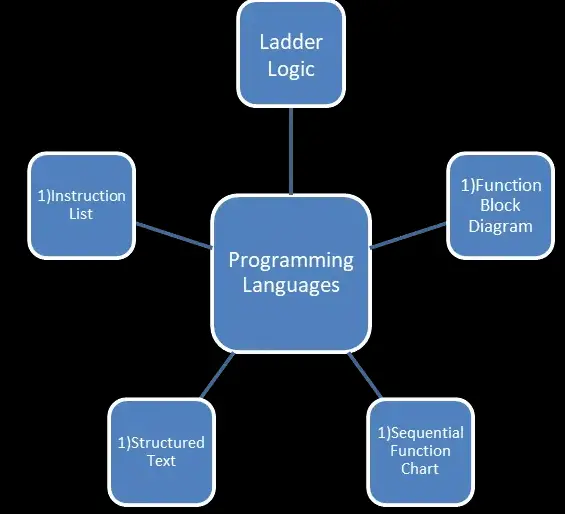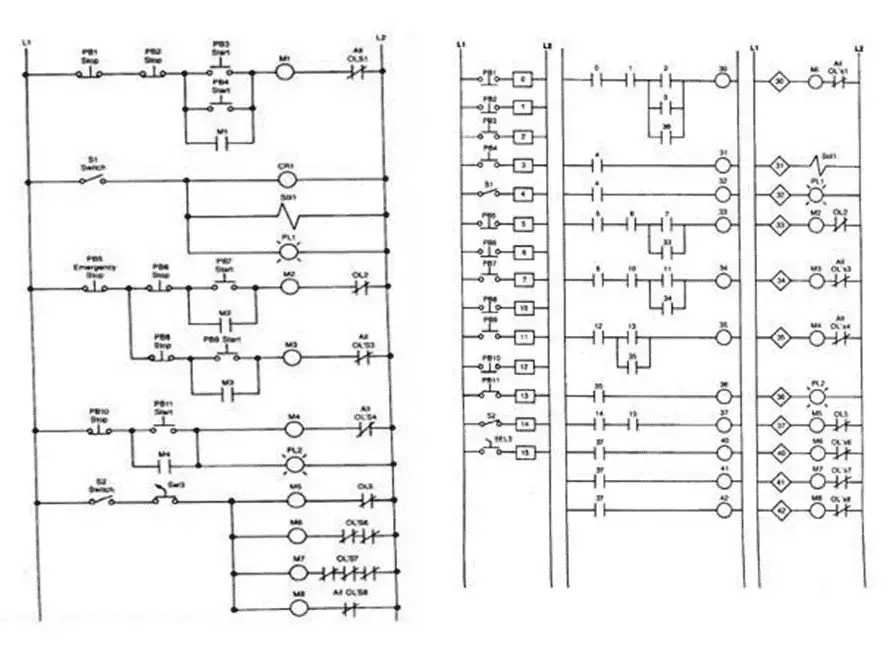The top 5 most popular types of PLC programming languages are ladder logic, function block diagram, sequential function chart, structured text, and instruction list. In the field of automation and control, systems like PLC, DCS, ESD, and F&G play a very important role.
These systems are the backbone of all kinds of process and safety systems available in any industry or even in-home automation. Programming plays one of the most important roles in these all systems. Whenever the word programming comes into our mind, then another word that immediately strikes our mind is what kind of programming language will be there?
Which are the top 5 programming languages?
There are five most popular types of PLC programming languages. These languages are a part of IEC 61131-3 (IEC stands for International Electrotechnical Commission). These languages are as follows.
- Ladder Logic
- Function Block Diagram
- Sequential Function Chart
- Structured Text
- Instruction List

Let us discuss each of these programming languages in detail with their advantages and drawbacks
Ladder Logic PLC Programming
Traditionally, relay logic was used for making logic and controlling plants. But the relay logic used to be too much complicated. Relay logic also consumed more space and had too much wiring. In case of any problem, debugging and troubleshooting become very difficult while using relay logic.
Ladder logic has also the same kind of background like that as relay logic. Ladder logic is the most commonly used programming language. Contact like Normally Open, Normally Closed, Timers, Counters, Latching Relay Output, and many more elements are used in Ladder Logic. Rungs are present which contain these elements which are connected according to the logic. The whole program is scanned in just a few milliseconds (depending upon the program length)

Advantages of Ladder Logic PLC Programming
- Ladder logic is one of the simplest forms of programming language.
- Ladder logic is written in the form of a rung. Hence, it becomes very easy to modify rungs as we can add new elements with just the drag-and-drop feature.
Drawbacks of Ladder Logic PLC Programming
- Ladder logic is simple to write but sometimes during troubleshooting, it becomes very difficult if the logic is big.
Function Block Diagram PLC Programming
From the name itself, it is clear that the functional block diagram uses functional blocks. The functional blocks are having some pre-defined set of inputs and outputs. We need to give the link between those functional blocks as per our logic. The function block diagram can be used to create more complex programs. For logic like logic for a pump or logic for an on-off valve, adding new logic to the new IO’s logic with the same logic becomes very easy as we need to simply use a function block already available for the pump or on-off valve.

Advantages of Function Block Diagram
- The function block diagram is very user-friendly.
- Complex programs can be easily written in function block diagram language.
Drawbacks of Function Block Diagram
- Bigger programs need more space (in terms of sheets); hence, visualizing the whole program might become troublesome sometimes in the case of function block diagrams.
Sequential Function Chart PLC Programming
Sequential function charts use steps to run the logic. A sequential function chart is like a flowchart. All the actions which need to be performed are written in steps and the next steps are decided upon the conditions written in the logic.

Advantages of Sequential Function Chart
- The sequential function chart is very user-friendly.
- Sequential function chart becomes easy for the plants having sequenced or batch process plants.
Drawbacks of Sequential Function Chart
- Bigger programs need more space (in terms of sheets) and hence visualizing the whole program might become troublesome sometimes.
- For continuous plants, sequential function chart type of programming cannot be used.
Structured Text PLC Programming
In structured text type of programming language, C or C++ type of language is used. In structured text type of programming language, the programmer writes the logic in the form of code like that of C language or C++ language. Hence, those who know C or C++ can easily understand this logic.

Advantages of Structured Text PLC Programming
- Advanced functionality in the structured text becomes easy.
Drawbacks of Structured Text PLC Programming
- Debugging and troubleshooting for the programs also becomes difficult which are written in structured text.
Instruction List PLC Programming
Instruction List is a type of low-level PLC programming language. The instruction list is obsolete in the IEC standard. This means that it is doubtful whether new PLCs will be programmed with an instruction list. An instruction list consists of some series of instructions that is similar to that of assembly language.
Advantages of Instruction List PLC Programming
- The codes written in the instruction list are easily understandable.
Drawbacks of Instruction List PLC Programming
- Modern PLCs don’t support instruction lists anymore.